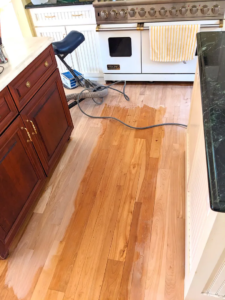Hardwood Floor Refinishing NJ are a beautiful feature in any home and can last for decades. However, over time they can become worn and damaged. Refinishing is a way to restore your hardwood and add years to its lifespan.
Before sanding, repair deep scratches and gouges with wood filler. Be sure to let it dry completely before sanding.

The first step in refinishing hardwood floors is to sand the old finish off. This is the most time-consuming and labor-intensive step in refinishing. It can be completed by a professional, but is not impossible for a homeowner to complete on their own with some preparation and patience.
This will require the use of a floor sander and a dust mask. It is best to sand in the direction of the wood grain to avoid causing damage and creating scratches. Start with a coarse grit, then move on to a medium and finally a fine sanding to prepare the surface for refinishing.
Once the sanding is complete, inspect the floor to determine how well it has been prepared for finishing. Check for squeaks or creeks that will need to be addressed, and look for any major scratches, gouges, or dents in the hardwood that cannot be resolved through cleaning or polishing (which fills in micro scratches).
If the damage is limited to the top layer of the existing finish, your flooring pro may recommend simply coating the hardwood instead of refinishing it. This is a less labor-intensive option, but the coating will not last as long as a refinishing.
While it is possible to refinish your hardwood floors yourself, this can be a very time-consuming and tedious project. Hiring a professional can save you a lot of time and effort, and will ensure your floors are refinished properly for the long-term.
Hardwood floor refinishing breathes new life into your existing floors and can make your entire home feel fresh and clean. It is a great way to increase the value of your home and improve its overall appearance.
If your hardwood is beginning to show signs of wear, don’t hesitate to contact us for a free estimate. We can help you decide whether or not refinishing is the right option for your floors, and help you choose the stain color that will complement your home. Our experienced professionals can also provide helpful tips and advice for maintaining your hardwood floors to extend their lifespan between refinishings.
Staining
Hardwood floor staining is a major decision that can change the overall look and feel of a room. It’s a process that can only be undone by re-sanding the floors and starting over, so it’s important to choose carefully.
It can be helpful to consult a color chart and a few paint samples before choosing your final stain. This will help you visualize the shade and make sure it complements the rest of your home’s décor. It’s also a good idea to consider the amount of natural light the room gets and how it will be used to determine what hue will be best for your floors.
Before you apply the stain, thoroughly clean the floor to remove any dust and other debris created during the sanding process. Vacuum and wipe down walls, ceilings and trim work as well to ensure a clean, uniform surface.
The wood’s grain plays a big role in its ability to accept and absorb the stain. Depending on the species of wood (oak, maple, cherry and birch are common examples) and your desired result, you may want to use a product called a “stain controller” to open the pores of the grain and help it accept more pigment.
Once you’ve cleaned the floor and prepared it for staining, apply a thin coat of polyurethane using a lambs wool applicator or a natural bristle brush. Let the first coat dry for several hours, then lightly sand it with 220-grit sandpaper to eliminate imperfections and smooth the surface. Repeat as needed, sanding and cleaning in manageable sections, and always working with the grain of the wood.
Staining hardwood floors isn’t as forgiving as painting a wall, so you will want to take the time to get it right. Make sure to test a few spots of the stain in an inconspicuous location and allow it to dry for a day before walking on it or moving furniture back in.
Keep in mind that once your floors are stained, you’ll need to protect them with a topcoat of protective sealant to keep them looking new for years to come. Apply the coats of sealant as directed, allowing each to dry between applications. To prolong the life of your refinished floors, place mats or rugs at entrances to catch dirt before it scratches the surfaces, and re-arrange furniture regularly to distribute wear evenly. Also, clean up spills and maintain indoor humidity between 30-50% to avoid moisture damage.
Resealing
Hardwood floors are durable, but over time they can suffer from scratches and dents. These flaws can make them look worn and dated, but refinishing is a good way to refresh your home and add value. However, before you go ahead and sand and stain your hardwood flooring, be sure to check with your BCC to ensure your contractor has the proper licenses, insurance, and bonding. This will help you avoid any hiccups during the process.
Most homeowners can handle sanding their own hardwood floors with a drum or orbital sander and sandpaper. However, this is a messy project that requires dust masks, ear protection, and protective eyewear. Before sanding, it’s important to clean your floor thoroughly and remove any furniture that can’t be moved temporarily. You should also cover any vents and doorways with painter’s tape and plastic sheeting.
Once your floors are sanded and cleaned, they can be prepared for recoating. Recoating is a less invasive option than refinishing, and can restore the appearance of your floors without removing all of the old finish. There are several different ways to recoat your hardwood floors, including chemical abrasion and wood revitalizers. To choose the right one for your floors, consider how much wear they receive and what their current condition is.
To determine if your hardwood floors are suitable for refinishing, it’s essential to know how thick the wear layer is. While this is typically printed on the floor’s label, you can also measure it by removing an air vent and examining the thickness of each board. You can also use a tool like a thermo-hygrometer to test for moisture levels in the room.
When the refinishing process is complete, your floors will need to dry completely before you can return your furniture. Be sure to allow plenty of time for this, and protect your furniture by placing felt tips on the bottom of the legs.
Refinishing your hardwood floors can dramatically improve their appearance and extend their lifespan. However, it is a major undertaking and can be quite costly. By following these simple tips, you can save money and ensure your floors are in pristine condition.
Finishing
While refinishing hardwood floors may seem like an impossible DIY task, there are steps that can be taken to make the project less stressful and more successful. First, make sure to purchase or rent the necessary equipment. Next, decide if you want to stain the floor or leave it unfinished. Staining is a great way to highlight the beauty of a particular wood type or to brighten up a dark room. If you decide to stain the floors, it’s important to test the color and hue on a small, hidden area of the floor before applying the new finish.
The sanding process can create a lot of dust, so be sure to take the time to clean thoroughly between each step. Once the sanding is complete, apply a sanding sealer to the entire floor and let it dry before moving on to the staining. Staining can be a lengthy process, so it’s important to work efficiently. Once the stain is applied, a polyurethane sealant can be used to protect the floors.
A new coat of finish will transform the look of your hardwood floors. Choose a lacquer, varnish or oil-based finish based on your preference. It’s recommended that you apply at least three coats, allowing each to dry in between. It’s best to apply the finish in the direction of the grain to ensure even coverage.
Once the final coat of finish is applied, wait a day or two (checking with the manufacturer’s instructions) before walking on the floors again and placing furniture. Place mats or rugs at doors and use felt pads on the feet of furniture pieces to prevent scratching the newly-refinished floors.
Regular maintenance can prolong the lifespan of hardwood floors and increase the time between refinishings. Clean floors regularly with a hardwood flooring cleaner or a mixture of water and white vinegar. Wipe spills immediately to avoid moisture damage, and keep indoor humidity between 30-50% to prevent warping. It’s also a good idea to re-arrange furniture occasionally to distribute wear evenly. With proper care, your hardwood floors will last for decades.




